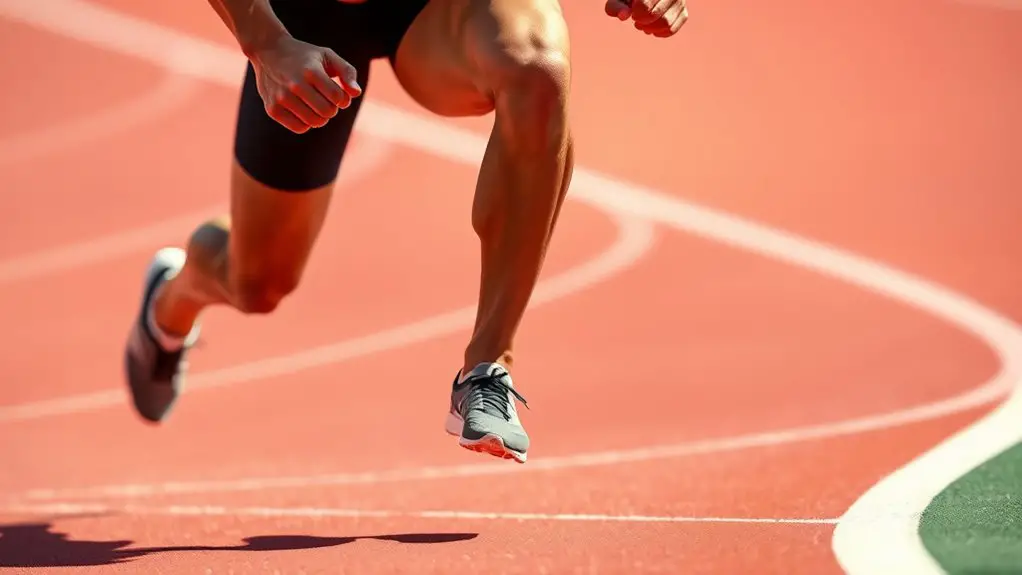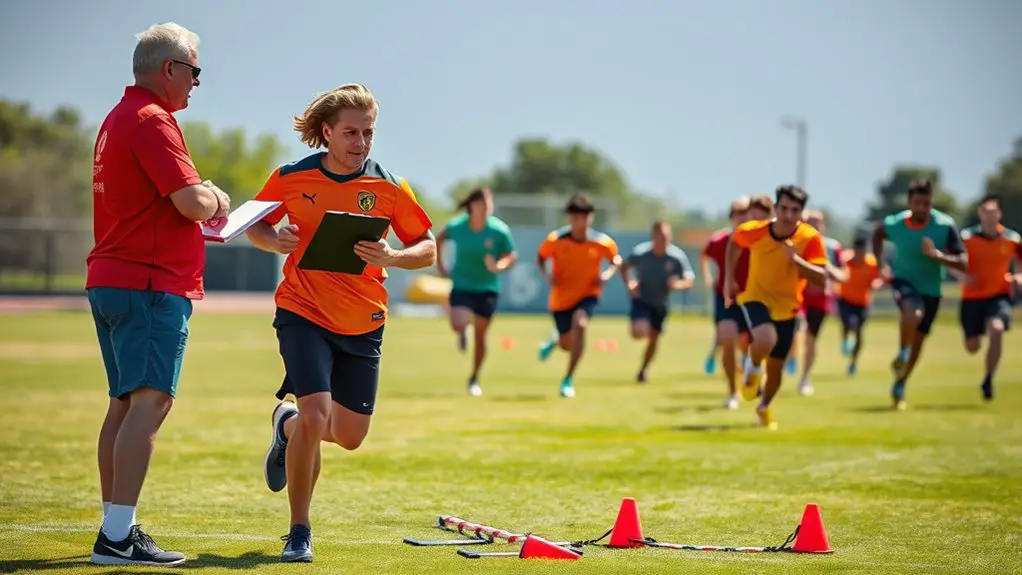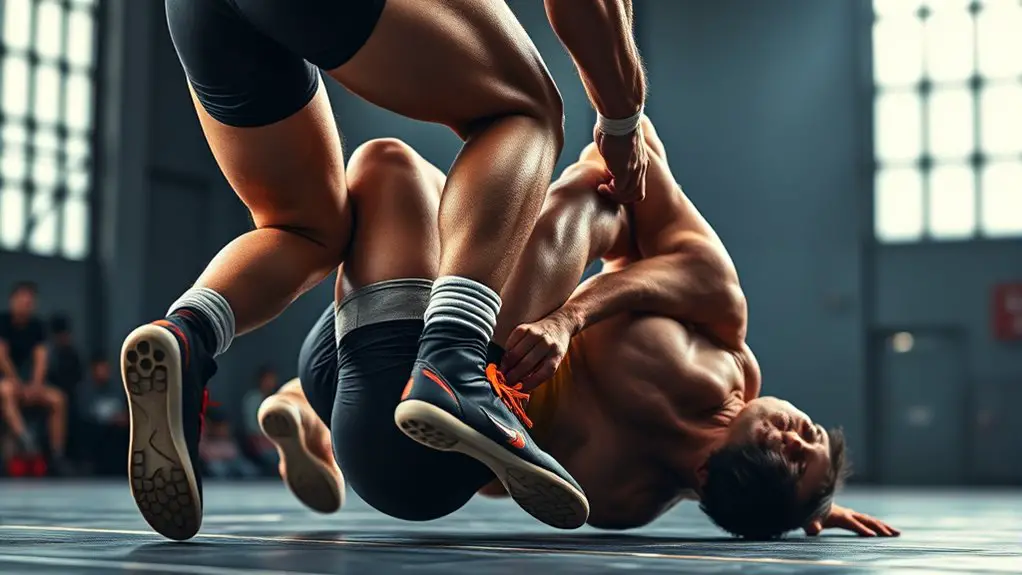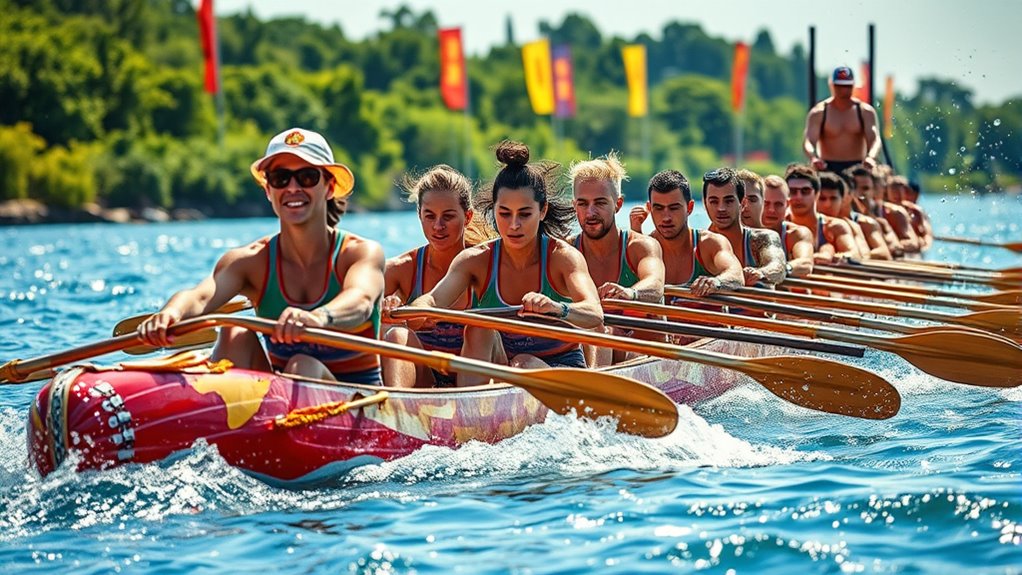The biomechanics of a perfect sprint stride relies on synchronized muscle activation, ideal posture, and effective movement techniques. You need to engage your core for stability, maintain a neutral spine for power, and control arm swing to enhance speed. Your foot strike pattern greatly affects acceleration and propulsion, while knee angles influence both stability and explosiveness. By fine-tuning these elements, you can elevate your sprinting performance. There's so much more to explore to enhance your technique.
Understanding the Sprinting Mechanics
When you think about sprinting mechanics, it's essential to grasp how your body moves in harmony to achieve maximum speed. Understanding the right sprinting techniques can set you loose on the track, allowing you to push your limits and feel the wind at your back. A thorough biomechanical analysis reveals how your limbs coordinate to propel you forward.
Focus on your arm swing; it's not just about legs. Your arms drive your legs, creating momentum and balance. Pay attention to your foot placement—landing on the balls of your feet helps with explosive speed. Engaging your core stabilizes your posture, letting you maintain that powerful stride. Additionally, incorporating acceleration drills can significantly enhance your initial burst and top speed.
As you explore deeper into these mechanics, you'll find that each element plays an essential role in your overall performance. Embrace this understanding, and you'll release your true sprinting potential, enjoying the exhilarating freedom of every stride.
The Role of Muscle Activation
Muscle activation plays a pivotal role in achieving an ideal sprint stride. When you sprint, your body relies on precise muscle recruitment and activation patterns to propel you forward. The right combination of muscle fibers firing at the right time can make all the difference in your performance and freedom on the track.
| Muscle Group | Activation Pattern |
|---|---|
| Quadriceps | Explosive during push-off |
| Hamstrings | Quick contraction for leg recovery |
| Calves | Powerful thrust for propulsion |
| Glutes | Stabilization and power generation |
| Core | Balance and support throughout |
Mastering these activation patterns not only enhances your speed but also frees you from the constraints of inefficient movement. Embracing the art of muscle activation will set you free, allowing you to sprint with both power and grace, ultimately releasing your true potential. Incorporating plyometric exercises into your training can significantly improve your muscle activation and explosive power.
Importance of Proper Posture
When sprinting, maintaining proper posture is essential for peak performance. You need to focus on spine alignment, head position, and core engagement to maximize your efficiency and speed. With the right posture, you'll not only run faster but also reduce your risk of injury. Additionally, core strength is crucial for stabilizing your body, allowing for more powerful and controlled movements during your sprint.
Spine Alignment Significance
Proper spine alignment plays an essential role in achieving ideal sprinting performance. When your spine's aligned, you enhance your spinal mobility, allowing for greater freedom of movement. This means you can push off the ground more effectively and maintain speed without unnecessary strain.
Here's a quick overview of key alignment techniques:
| Alignment Technique | Importance |
|---|---|
| Neutral Spine | Maximizes power output |
| Engaged Core | Stabilizes the pelvis |
| Relaxed Shoulders | Improves arm swing |
| Balanced Hips | Enhances stride length |
Head Position Essentials
Maintaining the right head position is essential for optimizing your sprinting performance. A proper alignment can enhance your speed and efficiency, giving you the freedom to reach your potential. Pay attention to these key aspects:
- Neutral head tilt: Keep your head aligned with your spine to avoid unnecessary strain.
- Gaze direction: Look straight ahead, focusing on your finish line, which helps maintain balance.
- Relaxed jaw: Tension in your jaw can lead to unnecessary tightness in your neck and shoulders.
- Shoulders down: Keep your shoulders relaxed and away from your ears to promote better airflow.
- Chin slightly up: This position helps open your airways, ensuring you get enough oxygen as you sprint.
Core Engagement Benefits
Core engagement plays an essential role in achieving ideal posture during sprints, as it stabilizes your entire body and allows for more efficient movement. When you activate your core, you create core stability, which supports your spine and pelvis, giving you the freedom to sprint without unnecessary strain. This stability helps maintain proper alignment, reducing the risk of injury and enhancing your performance. Engaging your core also generates dynamic tension, allowing for powerful strides while keeping your form intact. With a strong core, you'll feel more connected to the ground, making each sprint feel fluid and effortless. Embrace this engagement, and you'll reveal your full sprinting potential, enjoying the exhilarating freedom of speed and agility.
The Kinetic Chain in Sprinting
Although sprinting may seem like a simple act of running fast, it actually involves a complex interplay of movements that rely on the kinetic chain. Understanding this chain can reveal your potential by optimizing energy transfer throughout your body. Each segment, from your feet to your core, plays an essential role in generating speed and power.
- Foot strike: It initiates the kinetic chain, absorbing and transferring energy.
- Leg drive: Powerful knee lift and extension propel you forward.
- Hip engagement: Strong hips stabilize and optimize force application.
- Core stability: A solid core helps maintain body alignment and balance.
- Arm action: Coordinated arm movements enhance momentum and speed. Additionally, the proper arm movement ensures that energy is used efficiently, contributing to overall sprinting performance.
Optimal Knee Angles for Speed
When sprinting, the angle of your knee plays a vital role in your speed. Understanding the right knee flexion and extension can greatly enhance your acceleration and stride length. Let's explore how optimizing these angles can help you achieve your best performance. Additionally, maintaining proper body alignment is essential for maximizing your efficiency and minimizing strain during sprints.
Importance of Knee Flexion
Knee flexion plays an essential role in maximizing sprinting speed, as it directly influences your stride mechanics and power output. Proper knee flexibility and joint stability enhance your ability to maintain an efficient running form. When your knees flex efficiently, you can achieve greater stride length and frequency, fueling your sprinting potential. Here are key benefits of efficient knee flexion:
- Increases propulsion through powerful leg drive
- Enhances balance and stability during each stride
- Reduces the risk of injury by distributing forces evenly
- Improves overall running efficiency and speed
- Enables quicker recovery of the leg for the next step
Embracing the importance of knee flexion can unleash your true sprinting prowess, giving you the freedom to fly down the track.
Optimal Extension for Acceleration
To achieve ideal acceleration, you must focus on the extension phase of your stride, where the angle of your knee plays an essential role. Proper knee positioning can make or break your speed. Aim for the best leg positioning, ensuring your knee extends fully while keeping your foot close to the ground. This allows for an explosive push off that propels you forward with power and speed. Remember, it's not just about extending your leg; it's about how effectively you use that extension to generate momentum. The right knee angle maximizes your force and facilitates quicker acceleration, giving you the freedom to release your full sprinting potential. So, pay attention to those angles, and you'll feel the difference in your performance.
Impact on Stride Length
Achieving ideal speed hinges on your stride length, which is largely influenced by the angles at which your knees operate during each phase of your sprint. Best knee angles can enhance stride efficiency, allowing you to cover more ground without extra effort.
- Maintain a 90-degree angle at peak knee lift for maximum extension.
- Keep a low angle during foot strike to minimize ground contact time.
- Aim for a 45-degree angle during the drive phase to propel forward effectively.
- Focus on a slight bend in the knee during recovery to prepare for the next stride.
- Experiment with different angles to find what feels most natural for speed enhancement.
Unlocking these mechanics can lead to faster sprints and a liberating experience on the track.
Arm Movement and Its Impact
While many focus solely on leg movement, arm action plays an essential role in sprinting efficiency and speed. Your arm swing directly influences your sprinting dynamics, helping to maintain balance and rhythm. When you drive your arms forward and backward with purpose, you're not just looking cool; you're generating force that propels you forward.
Think of your arms as a counterbalance to your legs. The more effectively you move them, the more energy you transfer into each stride. If your arms are flailing or moving inefficiently, you lose momentum and speed. So, keep those elbows bent at about 90 degrees and let them move in sync with your legs.
Incorporating agility ladder drills into your training can help improve your overall coordination and enhance your sprinting performance.
Foot Strike Patterns and Ground Reaction Forces
Understanding foot strike patterns is essential for optimizing sprint performance, as they directly impact ground reaction forces and overall speed. The way your foot hits the ground can either propel you forward or slow you down. Here are some key points to evaluate:
- Forefoot strike: Engages your calves and promotes faster acceleration.
- Midfoot strike: Provides a balanced approach, minimizing ground reaction forces.
- Heel strike: Often leads to increased braking forces, slowing your momentum.
- Ground reaction forces: The force exerted by the ground can either enhance or hinder your sprint.
- Biomechanical efficiency: Proper foot strike patterns streamline energy use and boost performance. Additionally, high-intensity interval training can enhance your sprinting ability by improving aerobic capacity, which is essential for sustained speed.
The Influence of Stride Frequency and Length
Stride frequency and length play an important role in maximizing your sprinting potential, as they directly influence your overall speed and efficiency. You've gotta find the right balance between the two to release your full power. Stride frequency refers to how often you take strides within a given time, while stride length is the distance covered with each step.
Higher stride frequency can help you maintain momentum, but if your stride length is too short, you might not be covering enough ground. Conversely, if you focus solely on length, your frequency might drop, slowing you down. To achieve that sweet spot, it's vital to listen to your body and experiment with different combinations. Embrace the freedom to explore what works for you, and remember that optimizing your stride frequency and length can lead to exhilarating improvements in your sprinting performance. Additionally, incorporating plyometric exercises into your training regimen can enhance your explosive power and contribute to better acceleration. Every runner has their unique rhythm—find yours!
Techniques for Improving Sprint Performance
Finding the right balance between stride frequency and length is just the beginning of enhancing your sprinting capabilities. To truly elevate your performance, you'll need to focus on specific techniques that refine your form and boost your speed. Embrace the freedom to explore various methods, and incorporate these key strategies into your training:
- Sprint drills: Integrate high-knee runs and butt kicks to improve your mechanics.
- Technique refinement: Work on your arm swing to maintain balance and momentum.
- Strength training: Focus on your core and legs to generate more power.
- Flexibility exercises: Enhance your range of motion to prevent injury.
- Video analysis: Record your sprints to identify areas for improvement.
Additionally, incorporating interval training into your routine can significantly enhance your speed and endurance.
Frequently Asked Questions
How Does Sprinting Technique Vary Between Different Athletes?
When you look at how sprinting technique varies between different athletes, you'll notice differences in stride length and arm movement. Some athletes have a longer stride, allowing them to cover more ground quickly, while others optimize their cadence for speed. Your arm movement also plays a vital role; a strong, rhythmic swing can enhance your momentum. Each athlete finds their unique style, embracing what feels right for their body and maximizing their potential on the track.
What Common Injuries Are Associated With Sprinting?
Did you know that nearly 50% of sprinters experience injuries each year? If you're sprinting, be aware of common issues like hamstring strains and ankle sprains, which can really hold you back. Shin splints and knee tendinitis are also frequent problems that can disrupt your stride. To enjoy the freedom of running without pain, it's essential to pay attention to your body and incorporate proper warm-ups and recovery routines.
How Does Nutrition Impact Sprinting Performance?
Nutrition plays an essential role in your sprinting performance. You need a proper macronutrient balance—carbs for energy, protein for muscle recovery, and fats for endurance. Don't forget about hydration strategies, either; staying well-hydrated helps maintain your stamina and focus on the track. When you fuel your body right, you'll feel more free to push your limits and enjoy the thrill of sprinting without the worry of fatigue or cramping.
What Role Does Mental Focus Play in Sprinting?
When you think about sprinting, mental focus isn't just a theory; it's essential. Using mental imagery can help you visualize your sprint, enhancing your performance. Focus techniques, like mindfulness or positive affirmations, allow you to block distractions and stay in the moment. By honing your mental game, you liberate yourself from self-doubt, enabling you to channel your energy into every stride. Remember, a clear mind can elevate your sprint beyond physical limits.
How Can Footwear Affect Sprinting Efficiency?
Footwear can greatly impact your sprinting efficiency. The right footwear technology provides ideal support, cushioning, and traction, allowing you to harness your full potential on various sprinting surfaces. If your shoes match the terrain, you'll feel more confident and agile, reducing the risk of injury. A well-designed shoe adapts to your stride, enhancing comfort and performance, so you can focus on reaching your goals with freedom and determination.




